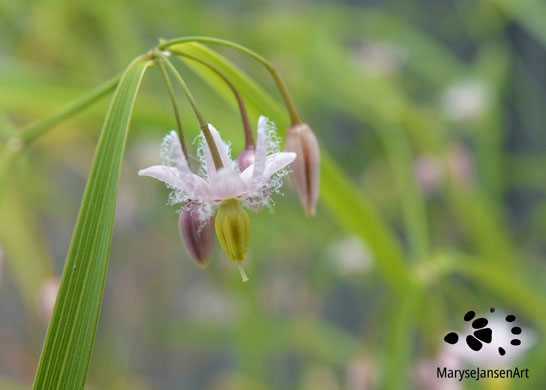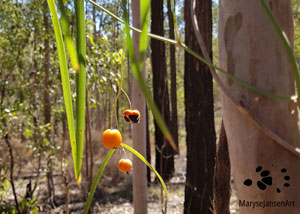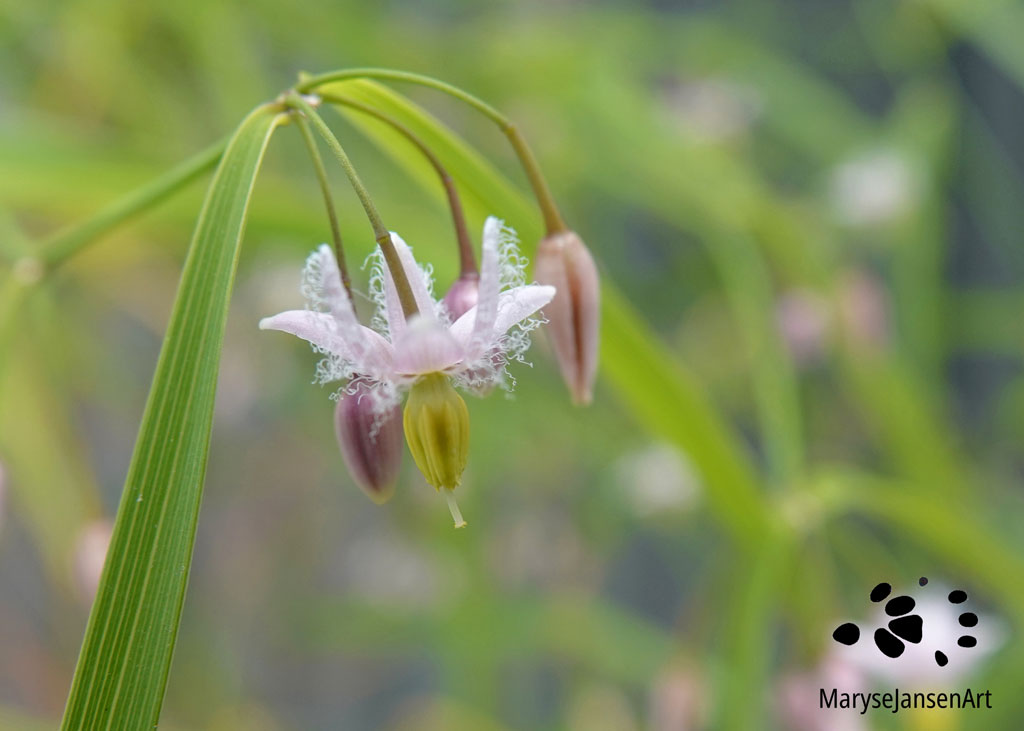Wildflower Photography with marysejansenart
Zooming in on small wildflowers – Part 1

Table of Contents
Intricate beauty
I thought spring would be a good time to zoom in on wildflowers. Even though in Australia you can find wildflowers year round, winter and spring are generally the best seasons to observe them. In this post I would like to take a look at a tiny flower: the flower of the Wombat Berry! Small flowers such as these are often overlooked. The beauty of a close-up photo of an Australian wildflower like this one is often surprising, since they are usually so small that you barely notice their intricate beauty with the naked eye unless you look closely! Just look at those delicate little frills! Amazing, isn’t it?
How I was introduced to the Wombat Berry
I would like to tell you about how I got to know and appreciate this plant. Not only does it have pretty little flowers, it’s an interesting plant for other reasons too. In the first years that we lived in Australia my child was at primary school age. One of the favourite home schooling activities that we did was visit local Environment Centres and take part in the school holiday workshops they had on offer. These were fantastic learning experiences and fun. We learned a great deal about the local flora and fauna, natives, weeds and pests and how to help the environment.
One memory that stands out for me was going on a walk in the nature reserve and learning about various plants and trees, including the ones that provided bush tucker and/or other uses for the Aboriginal People.
For my non-Australian readers: Bush–tucker means any wild animal, insect, plant or plant extract, etc traditionally used as food by native Australians.
Wombat Berry Fruit – a delicacy
At the time that we went on this particular walk we learned about the native Australian scrambling vine, called the Wombat Berry (Eustraphus latifolius). The plant produces attractive looking orange berries (about 1-2 cm in diameter). No wonder the alternative name is ‘Orange Vine’. Birds love to feast on these berries. We picked one of the berries and opened it. Inside we found black seeds and a little bit of crisp white flesh.

We learned this is a bush-tucker plant and the flesh of these berries is edible for humans! We tried it and it tasted mildly sweet. We also learned that wombat berry tubers can be eaten as well, either raw or baked. They are said to have a mild sweet earthy flavour. Wombats and other root-eating mammals eat these tuberous roots which explains why the plant is named after the wombat!
It’s a very useful plant as besides providing food it serves another purpose as well. Aboriginals also stripped the wiry vines of their leaves to be able to use them to bind objects together.
Check out my other posts about bush tucker plants here.
Warning
Before you have a go at trying any type of bush tucker I have to give you an important warning! Some bush tucker plants are very similar to other plants that may contain poisonous compounds. These plants could make you ill when consumed, or even lead to death. Even when you do correctly identify the plant, a minority of people may experience an allergic reaction to certain substances in the bush tucker that are harmless to most people. In some cases, the bush tucker needs appropriate preparations before it can be consumed safely.
A safe way to explore bush tucker is to buy seedlings of bush-tucker plants at a native nursery and plant them in your garden. Some of these nurseries may organise workshops and bush-tucker tastings to help you choose. If you don’t like the taste of it after all the native animals will definitely be grateful that you planted it in your backyard! And you will be able to enjoy their company and of course the pretty flowers!
Wombat Berry Facts
- The scientific name of this wiry, scrambling vine is Eustraphus latifolius. When unsupported it can grow in a clump.
- It has long, narrow green leaves (10 cm long) with longitudinal veins
- It blooms in spring with pretty little white to pinkish fringed flowers (1 cm) that grow in clusters, while the flower buds look more purplish
- After flowering orange berries (1-2 cm) are produced, which contain black seeds and white flesh
- The flesh of the berries as well as the tuberous roots are edible bush-tucker
- The plant attracts birds that eat the berries and mammals – including wombats – that eat the tubers
- It grows in wet and dry forests and heath lands of eastern Australia (Queensland, New South Wales and Victoria)
If you are interested in purchasing ‘Flowering Wombat Berry’ or would like to see what it looks like on the various products, please visit my shop.
Go to ‘Zooming in on small wildflowers – part 2’ here: 5 Pretty Pea Flowers decorating the Australian Bush.


